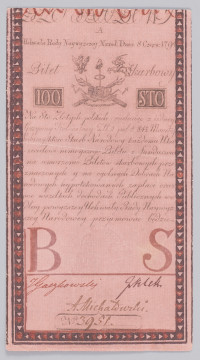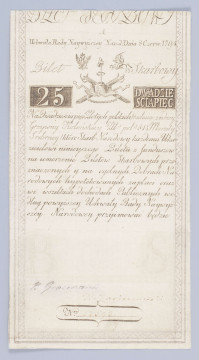
Treasury ticket - 500 Polish zlotys
1794
National Museum in Lublin
Part of the collection: Paper money of the Kościuszko Uprising and the Duchy of Warsaw
The main reason for the introduction of paper money by the Kościuszko Uprising authorities was the lack of bullion needed to mint coins. Thus, the introduction of insurrectionary treasury tickets into circulation was not the realisation of a carefully planned undertaking, but only a kind of ad hoc remedy. What is more, the insurgent authorities assumed that the paper money would only temporarily replace the bullion coin. It was expressed in assurances addressed to the public that, after the end of the uprising, tickets would be exchanged for coins in a ratio of 1:1. Such an approach to the matter meant that paper money was not popular. The lack of trust was further exacerbated by an ill-considered decision of the Uprising authorities, which allowed only half of the financial obligations towards the treasury to be paid in treasury tickets. The remaining part was to be paid in coin. Even the repeal of that decision did little to change public attitudes. During the Kościuszko Uprising, treasury tickets were put into circulation in three issues. The first of them included originally planned tickets with the face values of 5, 10, 25, 50, 100, 500 and 1000 zlotys. The issue was planned to have a total value of 60 million zloty at that time. The relevant decision was taken on 8 June 1794, and the tickets went into circulation on 16 August that year. Three days earlier a second issue was decided, comprising tickets of 5 and 10 groszy, as well as 1 zloty. It was to include tickets worth a total of 6 million zloty. It was implemented in three stages: from 10 October for the 5-grosz tickets, from 20 October for 20-grosz and from 1 November for 1 zloty. The decision about the third issue, planned for 8 million zlotys and involving only four-zloty tickets, was made, although – paradoxically – they went into circulation on 27 September 1794, i.e., earlier than the tickets of the second issue. However, the range of the issue was limited, as the four-zloty tickets went exclusively to the inhabitants of Warsaw. In total, an issue worth as much as 74 million zloty was planned, but ultimately fewer than 2.4 million tickets of various denominations, worth less than 11 million zloty, went into circulation.
Leszek Poniewozik
Dimensions
cały obiekt: height: 96 mm, width: 181 mm
Object type
paper money
Technique
woodcut
Creation time / dating
Creation / finding place
Owner
The National Museum in Lublin
Identification number
Location / status

1794
National Museum in Lublin

1794
National Museum in Lublin

1794
National Museum in Lublin
DISCOVER this TOPIC
Museum of King Jan III's Palace at Wilanów
DISCOVER this PATH
Educational path